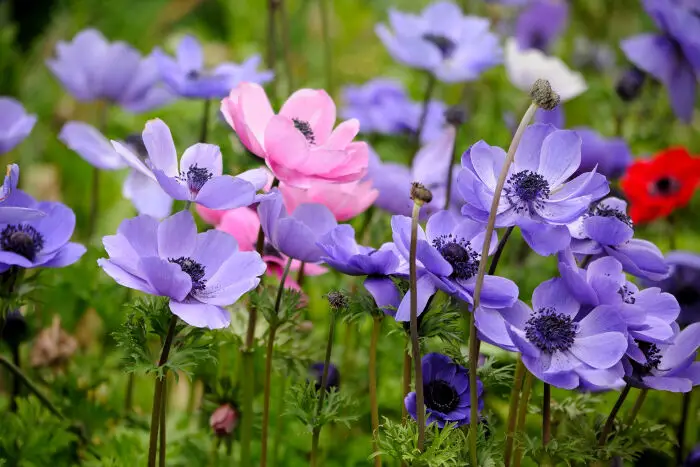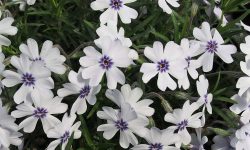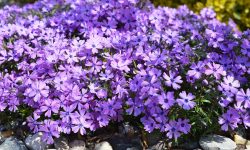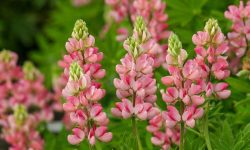Anemones are among the most enchanting flowers a gardener can grow, with their delicate petals and vivid colors that brighten any landscape. Often called windflowers, they capture the spirit of seasonal change, symbolizing both renewal and endurance. Many gardeners are drawn to their beauty but often ask a common question: when do anemones bloom? The answer varies depending on the species, growing region, and care they receive.
Some anemones burst into bloom in early spring, announcing the end of winter with cheerful hues, while others save their display for fall, creating a vibrant finale to the gardening year. By learning the natural blooming cycles and applying proven techniques to extend flowering, you can enjoy anemones across multiple seasons. This guide offers expert tips to help you unlock the secrets of their timing and create lasting color in your garden.
Understanding Anemone Varieties and Bloom Times

Anemones are incredibly diverse, and each type has its own unique blooming period. Some varieties are known for bringing early color to the garden, while others wait until the end of the season to shine. Understanding the range of bloom times is essential for gardeners who want a continuous display. By selecting the right mix of species, you can enjoy a succession of blossoms that stretches from spring through fall. The key lies in knowing how each variety responds to seasonal changes.
Spring-blooming anemones, such as Anemone blanda, are among the first to appear after winter. Their dainty flowers in shades of white, pink, and blue spread across the garden floor, pairing well with other spring favorites like tulips and daffodils. Later in the year, Japanese anemones, including Anemone hupehensis and Anemone japonica, create a dramatic display. Their larger, more striking flowers provide vibrant color from late summer through the first frosts, ensuring the garden remains lively long after many plants have faded.
Blooming patterns are also shaped by climate, soil, and sunlight exposure. Cooler climates may delay flowering, while warmer regions often encourage earlier blossoms. Well-drained soil and consistent moisture support healthy growth, further influencing bloom timing. Gardeners who combine early and late-blooming varieties not only extend the season but also add layers of interest to the landscape. With careful selection and planning, it is possible to design a garden where anemones provide beauty across multiple seasons, from the first signs of spring until the crisp days of autumn.
Factors Influencing Anemone Blooming
Climate and Temperature
Climate strongly determines how long and when anemones bloom. In regions with long, cold winters, spring-flowering species such as Anemone blanda often wait until late April or May to open. In mild climates, the same variety may flower as early as March, offering a longer display. Late frosts remain a serious risk, as they can damage tender shoots and delay blooms for weeks. Covering plants with frost cloth or mulch provides valuable protection against sudden cold.
Temperature stability also affects bloom quality and duration. Spring types prefer cool, consistent conditions, while fall-blooming Japanese anemones thrive when late summer warmth gives way to autumn. Extreme heat can reduce flower size, and unexpected cold can shorten the blooming window. Choosing varieties suited to your local climate and monitoring weather changes helps gardeners secure reliable flowering. With thoughtful care, blooms can arrive on schedule and last longer in every season.
Soil Quality and Drainage
Soil is a critical foundation for healthy growth and abundant flowers. Anemones thrive in fertile, humus-rich soils that retain some moisture but still allow excellent drainage. Heavy clay restricts oxygen flow and traps water, causing roots to rot, while sandy soil drains too quickly, leaving plants thirsty and stressed. Amending soil with compost and organic matter improves structure, fertility, and water balance, creating the ideal environment for root development.
Drainage is essential for sustaining bloom cycles across the season. Roots require oxygen and steady moisture to fuel flower production. Waterlogged soil suffocates roots, resulting in weak stems and poor blooming. Gardeners can solve this by planting in raised beds, adding grit or perlite, or choosing naturally well-drained sites. With balanced soil conditions, anemones allocate more energy to strong flowering rather than survival. Consistent soil care ensures vibrant, healthy blooms year after year.
Sunlight Exposure
Light availability is another major influence on anemone flowering. While these plants enjoy some shade, too little light often reduces blooms significantly. In deeply shaded areas, anemones may produce only foliage without flowers. Conversely, exposure to intense midday or afternoon sun can cause petals to fade quickly and shorten the bloom period. Proper light management is vital for both flower quality and longevity.
Most varieties perform best with morning sunlight and partial afternoon shade. This allows enough energy for photosynthesis while shielding delicate petals from scorching heat. In cooler climates, anemones tolerate more sun, while in warmer regions, protection from harsh rays is essential. Observing sunlight patterns in your garden and adjusting placement ensures optimal flowering conditions. With balanced exposure, plants stay healthier, and their blossoms remain vivid and long-lasting throughout the season.
Moisture and Watering
Moisture is one of the most critical elements affecting anemone blooming. These plants prefer soil that remains consistently damp but not saturated, as excessive water can suffocate roots and invite fungal diseases. Spring-blooming anemones often benefit from seasonal rainfall, yet in regions with unpredictable weather, a steady watering schedule ensures plants do not dry out. Applying organic mulch helps retain moisture, prevents soil compaction, and keeps roots cool, which is particularly valuable during sudden warm spells.
Fall-flowering anemones demand even greater attention to watering because of their extended blooming cycle. If left too dry, the plants may produce fewer flowers or shorten their blooming window. Deep, infrequent watering encourages roots to grow downward, strengthening their resilience against heat or drought. A balance between hydration and drainage is key; well-aerated soil prevents water from pooling around the crown. With consistent watering practices tailored to seasonal needs, anemones reward gardeners with rich, long-lasting blooms that enhance any landscape.
Seasonal Care Practices
Seasonal maintenance shapes how long and how beautifully anemones flower. In spring, cleaning away old foliage and feeding with a balanced fertilizer prepares plants for strong growth. Adding compost not only improves soil health but also boosts bloom production. Gardeners can extend spring flowering by deadheading regularly, preventing plants from diverting energy into seed development. Simple care steps in early growth stages can significantly influence the vibrancy and abundance of blooms.
Fall-blooming varieties require a different seasonal approach. Cutting back stems after flowering helps conserve plant energy for the following year. In colder climates, a thick mulch layer around the crown shields roots from frost damage, ensuring their survival. During summer, maintaining soil moisture is vital to set up a strong fall display, while in autumn, consistent watering and light feeding help sustain long-lasting flowers. By aligning care with seasonal cycles, gardeners ensure their anemones bloom at peak performance year after year.
Soil Quality
Healthy soil provides the base for strong growth and reliable anemone blooming. These plants perform best in rich, well-drained soil with plenty of organic matter to nourish roots. Heavy clay holds too much water and risks rot, while sandy soil drains quickly and leaves plants stressed. Amending with compost, leaf mold, or well-rotted manure boosts fertility, improves structure, and helps soil retain steady moisture. A slightly acidic to neutral pH, ideally between 6.0 and 7.0, supports nutrient uptake and consistent flowering.
Proper preparation is equally important before planting. Loosening the ground to 8–10 inches encourages root expansion and ensures the plant establishes quickly. Mulching adds nutrients while regulating temperature and moisture, which is vital in both spring and autumn. Over time, organic amendments transform poor soil into a fertile base that sustains year after year of flowering. A light application of slow-release fertilizer in early growth stages provides lasting support. By investing effort in soil quality, gardeners set the stage for lush foliage, long-lasting flowers, and anemones that thrive season after season.
Sunlight Exposure
Light is one of the strongest influences on bloom timing and quality in anemones. Most spring-blooming species, such as Anemone blanda, thrive in dappled or partial shade, where they benefit from gentle morning light while being shielded from harsh afternoon sun. Fall-flowering Japanese anemones tolerate brighter conditions, flourishing in full morning sun combined with light shade later in the day. Matching each type to its ideal exposure allows the plants to achieve their natural blooming rhythm with abundant flowers.
Problems occur when lighting is unbalanced. Too little sun weakens stems, reduces blooms, and encourages sparse growth, while too much direct heat may scorch leaves and shorten flower life. Observing how sunlight moves through the garden helps in selecting the right planting spot. In hotter climates, filtered shade during midday can extend blooming, while in cooler regions, more direct sunlight may be beneficial. Providing optimal light conditions is one of the simplest yet most effective ways to unlock the full blooming potential of anemones.
Understanding Bloom Duration
Anemones are admired not only for their beauty but also for the way their blooming periods vary. Depending on the species, they may flower for just a few short weeks or extend their display over several months. Spring-blooming types like Anemone nemorosa and Anemone blanda typically flower for two to three weeks in cool weather before fading as summer heat arrives. In contrast, fall-blooming Japanese anemones can provide color from late summer through mid-autumn, often lasting up to eight weeks or more with the right care.
Bloom duration is strongly influenced by local climate. In cooler regions with mild springs, flowers tend to last longer, as lower temperatures prevent wilting. Warmer climates may shorten the bloom cycle, especially for delicate spring species. Gardeners can extend the flowering window by planting in partially shaded spots that reduce stress from strong sun. Combining multiple anemone varieties with staggered blooming times creates a layered display that stretches the season naturally.
Proper care also plays a role in bloom longevity. Regular watering, nutrient-rich soil, and the removal of spent flowers help plants focus energy on producing new blossoms. Mulching keeps the root zone stable, which further supports healthy flowering. For fall anemones, consistent hydration during dry spells ensures flowers remain vibrant into autumn. By understanding the natural patterns of bloom duration and supporting them with attentive care, gardeners can enjoy anemones at their fullest potential for weeks or even months.
Extending the Bloom Season
Gardeners often wonder how to enjoy the beauty of anemones for as long as possible, and with the right strategies, it is entirely achievable. The simplest approach is to combine both spring- and fall-flowering varieties in the same garden. By doing so, you can create a seamless transition of color that begins as early as March and continues well into October. Layering species with staggered bloom times ensures there is always something in flower, even as the seasons shift. Succession planting with different cultivars also helps keep beds vibrant for months.
Proper placement is another effective way to extend blooming. Planting spring varieties in areas with partial shade keeps soil cooler and delays fading, while situating fall types in spots that receive morning sun and afternoon shade protects their flowers from stress. Providing mulch around the base helps conserve moisture and regulate soil temperature, both of which contribute to longer-lasting blooms. In regions with unpredictable weather, these measures stabilize growing conditions, making flowers more resilient and reliable.
Finally, maintenance practices are critical for prolonging bloom duration. Regular deadheading encourages continued flower production rather than seed formation, while feeding with a balanced fertilizer provides the energy needed for sustained growth. Watering consistently during dry spells, especially for fall-blooming varieties, prevents premature wilting and keeps flowers looking fresh. Dividing overcrowded clumps every few years also rejuvenates plants, giving them renewed vigor. By combining variety selection, smart placement, and attentive care, gardeners can significantly extend the bloom season and enjoy a garden full of color for many months of the year.
Care Tips for Prolonged Blooms
Proper Fertilization
Fertilization is one of the most effective ways to support anemones throughout their blooming season. These plants prefer a balanced, slow-release fertilizer applied in early growth stages, which provides steady nutrients as they prepare to flower. Organic options such as compost, worm castings, or liquid seaweed feed not only enrich the soil but also improve its texture, helping roots absorb water and minerals more efficiently. Stronger roots mean stronger flowers, and consistent feeding ensures healthier, more vibrant blooms.
Timing also matters when fertilizing anemones. Feeding once in early spring for spring-blooming varieties, and again in midsummer for fall types, gives them the boost they need. Overfertilizing, however, can lead to excessive leaf growth at the expense of flowers. Gardeners should aim for moderate applications that encourage balance. Supplementing with micronutrients like potassium and phosphorus enhances bloom production. With thoughtful fertilization, anemones are better equipped to produce abundant, long-lasting blossoms that extend the garden’s beauty across the seasons.
Deadheading and Pruning
Deadheading is a simple yet powerful method for prolonging anemone blooming. By removing spent flowers before they set seed, gardeners redirect the plant’s energy into creating new blossoms rather than reproduction. This process is especially useful for fall-blooming anemones, which can continue flowering for several weeks if regularly maintained. Deadheading also keeps plants tidy, reducing the risk of fungal diseases that thrive in decaying petals and damp conditions.
Pruning plays a supportive role in sustaining blooms. Cutting back damaged or weak stems allows stronger shoots to receive more nutrients and light, which improves overall flower quality. For spring-blooming types, light pruning after flowering helps prepare plants for dormancy, while fall types benefit from trimming after the first frost. Regular seasonal pruning also prevents overcrowding, ensuring air circulation within the clump. These practices not only extend flowering but also keep the plants vigorous year after year. Regular attention with shears ensures that anemones remain a reliable highlight of the garden.
Watering Strategies
Consistent watering is essential for promoting long-lasting anemone blooms. These plants prefer evenly moist soil that never becomes waterlogged. Spring-blooming varieties benefit from natural rainfall, but in drier climates, supplemental watering ensures steady growth and abundant flowers. Deep watering once or twice a week encourages roots to grow downward, creating stronger plants that can withstand brief dry spells. Shallow, frequent watering should be avoided, as it promotes weak root development and reduces flower quality.
Fall-blooming anemones require particularly attentive watering because their flowering period is longer. Dry soil can cause smaller flowers, premature wilting, or shortened bloom duration. Gardeners should monitor soil moisture and adjust irrigation during heat waves or drought. Combining deep watering with mulching around the plant base helps conserve moisture, regulates temperature, and prevents stress. Proper watering strategies support healthy root systems and maximize flowering potential, ensuring that anemones remain vibrant and visually appealing throughout their bloom season.
Mulching Benefits
Mulching offers multiple advantages that directly enhance anemone bloom longevity. A layer of organic mulch, such as shredded bark, compost, or leaf mold, retains soil moisture, reducing the frequency of watering. Mulch also acts as insulation, keeping roots cool in summer and protecting them from frost during winter. By regulating soil temperature, mulch creates an environment conducive to steady growth and prolonged flowering, helping plants maintain energy for continuous blooms.
Mulching also improves soil structure over time. As organic materials decompose, they add nutrients and increase microbial activity, promoting healthier roots and stronger flowers. Additionally, mulch suppresses weeds that compete for water and nutrients, reducing stress on anemones. Applying a 2–3 inch layer around plants, while keeping it slightly away from the crown to prevent rot, ensures maximum benefit. With proper mulching, gardeners can extend bloom duration, improve plant health, and enjoy a more vibrant garden throughout the season.
Common Mistakes to Avoid for Better Bloom
Overwatering
Overwatering is one of the most common mistakes gardeners make with anemones. While these plants need consistent moisture, excessive watering can quickly lead to root rot, fungal infections, and weak stems that struggle to support blooms. Waterlogged soil deprives roots of oxygen, preventing proper nutrient uptake and reducing flower size and quantity. Signs of overwatering include yellowing leaves, wilting, and stunted growth, all of which signal stress and hinder flowering. Gardeners must monitor soil moisture and water only when the top inch of soil feels slightly dry.
Preventing overwatering involves improving soil drainage and choosing well-drained planting sites. Raised beds or containers can be useful in areas with heavy clay soil. Deep, infrequent watering encourages roots to grow downward and develop resilience, while shallow, frequent watering promotes weak, surface-rooted plants. Mulching helps regulate moisture levels and prevent sudden spikes, maintaining a stable environment for healthy growth. By carefully managing irrigation, gardeners can enjoy stronger plants with vibrant, long-lasting blooms throughout the season.
Planting in the Wrong Location
Planting anemones in an unsuitable location is another frequent error that negatively affects bloom quality. Spring-blooming species need partial shade and cooler soil, whereas fall-blooming varieties perform best with morning sunlight and afternoon protection from heat. Planting in deep shade reduces flower production, and intense afternoon sun can scorch petals or shorten bloom duration. Choosing the correct location ensures plants receive the light they need without experiencing stress that compromises health and flowering.
Understanding light patterns throughout the garden is essential. Observing how sun moves across different seasons helps determine optimal spots for planting. Overcrowding is also a location-related concern, as closely planted clumps limit airflow, increase humidity, and foster fungal disease. Adequate spacing allows roots to access nutrients and water efficiently while providing room for stems to grow upright. By selecting appropriate locations and spacing plants thoughtfully, gardeners maximize flowering potential, creating a garden that consistently produces vibrant, long-lasting blooms.
Neglecting Seasonal Care
Neglecting seasonal care significantly reduces anemone bloom duration and quality. Failing to fertilize, prune, or deadhead weakens the plant and diverts energy away from flower production. For spring-blooming varieties, removing dead foliage after flowering, applying balanced fertilizer, and lightly pruning encourages energy storage for the next season. Fall-blooming anemones benefit from trimming after the first frost, maintaining consistent soil moisture, and removing damaged stems to support continued flowering.
Neglect also allows weeds to compete for nutrients, water, and light, increasing stress and further reducing blooms. Applying mulch, monitoring soil moisture, and performing timely deadheading all contribute to healthier, more vigorous plants. Consistent seasonal care prevents pest and disease problems and ensures that anemones reach their full flowering potential. Gardeners who commit to these maintenance practices enjoy a longer, more vibrant blooming period, stronger plant resilience, and an overall more attractive garden throughout the growing season.
Increasing Bloom Success Through Propagation
Dividing Clumps
Dividing anemone clumps is a highly effective method for increasing bloom success and revitalizing older plants. Over time, individual clumps can become overcrowded, restricting airflow and reducing nutrient availability, which often results in smaller flowers and weaker stems. The best time to divide spring-blooming varieties is immediately after flowering, while fall-blooming types should be divided in early spring before active growth begins. Gently lift the entire clump from the soil, carefully separate it into smaller sections ensuring each has a healthy root system and at least one growing bud, and replant them in prepared, well-draining soil.
Proper spacing after division is crucial to maintain healthy growth. Each new section should have enough room to spread without competing for light, water, or nutrients. Dividing rejuvenates older plants, encourages robust root systems, and supports the production of larger, more vibrant flowers in subsequent seasons. Combining this method with fertilization, mulching, and consistent care ensures that divided anemones flourish and bloom reliably year after year, providing a continuous display of color and vitality in the garden. This approach is particularly valuable for gardeners seeking to expand their planting area while maintaining the health and performance of their existing plants.
Growing from Seeds
Propagating anemones from seeds is a rewarding method for expanding the garden and introducing genetic diversity. Spring-blooming species produce seeds that can be sown immediately after ripening, while fall-blooming varieties often require stratification—a cold treatment that mimics winter conditions—to break dormancy and encourage germination. Seeds should be planted in well-draining soil, kept evenly moist, and protected from direct harsh sunlight. Consistent moisture and a stable environment are critical for germination, which can take several weeks to months depending on the species.
Growing from seed allows gardeners to experiment with new varieties and select plants with desirable traits such as unique flower colors or improved resilience. Patience is essential, as seedlings may require one or two growing seasons before flowering. Gradually acclimating seedlings to sunlight strengthens stems and prepares them for transplanting into garden beds. By combining proper stratification, soil preparation, and attentive care, gardeners can successfully propagate multiple healthy anemones from seeds, ensuring a steady supply of flowering plants while promoting diversity and long-term garden vitality.
Using Root Cuttings
Root cuttings provide a reliable way to propagate anemones while preserving the parent plant’s characteristics. Select thick, healthy roots from mature plants during the dormant season. Cut them into 2–3 inch segments, ensuring each piece has at least one growing point. Plant the cuttings in moist, well-draining soil, covering lightly to encourage root development, and keep them in a shaded, protected area until shoots emerge. This method bypasses slow seed germination and produces genetically identical plants that retain desirable flower traits such as color and size.
Regular monitoring is key to success with root cuttings. Ensure the soil remains moist but not waterlogged, as overly wet conditions can cause rot. Once shoots appear, gradually acclimate young plants to sunlight to strengthen stems. This propagation technique allows gardeners to multiply anemones efficiently, producing multiple healthy flowering plants from a single parent. Combining root cuttings with fertilization, mulching, and seasonal care maximizes bloom success, ensuring that newly propagated anemones thrive and contribute to long-lasting, vibrant garden displays year after year.
FAQ When Anemones Bloom
When is the best time to plant anemones?
The ideal time to plant anemones depends on the variety. Spring-blooming types are best planted in the fall to allow roots to establish before cold weather. Fall-blooming Japanese anemones should be planted in spring or early summer to ensure sufficient growth before cooler temperatures arrive. Proper planting timing supports root development and encourages vibrant, long-lasting blooms.
How often should I water anemones?
Anemones require consistently moist soil but should never sit in waterlogged conditions. Deep, infrequent watering once or twice a week encourages strong root systems, while shallow, frequent watering can cause weak growth. Adjust frequency according to rainfall, temperature, and soil type to maintain steady moisture levels that support prolonged flowering.
Can anemones be propagated from seeds or root cuttings?
Yes, both methods are effective. Seeds allow gardeners to expand collections and promote genetic diversity, while root cuttings produce genetically identical plants with faster bloom potential. Proper care, soil preparation, and shading are essential for successful propagation using either method.
How do I extend the bloom season of anemones?
Combining spring- and fall-flowering varieties ensures continuous color. Strategic placement in partial shade or morning sun, regular deadheading, mulching, and consistent watering all help prolong bloom duration. Selecting varieties with staggered flowering times also contributes to a longer, vibrant display.
What common mistakes reduce flowering in anemones?
Overwatering, planting in unsuitable locations, neglecting seasonal care, and overcrowding are common issues. Each can limit flower production, shorten bloom duration, and increase susceptibility to disease. Correcting these mistakes promotes healthier plants and more reliable flowering year after year.
Conclusion
Understanding anemone blooming patterns and applying proper care practices ensures maximum beauty and longevity. Factors such as soil quality, sunlight, moisture, fertilization, and seasonal maintenance all influence flower performance. By avoiding common mistakes and employing effective propagation techniques, gardeners can enjoy vibrant, long-lasting blooms. Combining spring- and fall-blooming varieties extends the season, while deadheading, pruning, and mulching maintain plant health. Whether planting from seed, dividing clumps, or using root cuttings, attentive care guarantees a resilient garden full of color. With dedication and knowledge, any gardener can cultivate anemones that thrive and consistently produce stunning, eye-catching flowers throughout the year.






